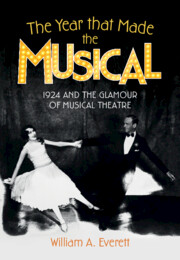Book contents
- The Year that Made the Musical
- Reviews
- The Year that Made the Musical
- Copyright page
- Dedication
- Contents
- Plates
- Figures
- Acknowledgements
- Chronology
- Abbreviations
- Part I From One Year to the Next
- 1 Legacies
- 2 Transnational Connections
- 3 Playing on the Past
- 4 Getting Ready for 1924
- Part II From Winter to Spring
- Part III From Summer to Autumn
- Part IV From December Onwards
- Select Discography and Videography
- Permissions
- Select Bibliography
- Index
- Plate Section (PDF Only)
1 - Legacies
from Part I - From One Year to the Next
Published online by Cambridge University Press: 26 September 2024
- The Year that Made the Musical
- Reviews
- The Year that Made the Musical
- Copyright page
- Dedication
- Contents
- Plates
- Figures
- Acknowledgements
- Chronology
- Abbreviations
- Part I From One Year to the Next
- 1 Legacies
- 2 Transnational Connections
- 3 Playing on the Past
- 4 Getting Ready for 1924
- Part II From Winter to Spring
- Part III From Summer to Autumn
- Part IV From December Onwards
- Select Discography and Videography
- Permissions
- Select Bibliography
- Index
- Plate Section (PDF Only)
Summary
After a contextual overview of events in 1924, the legacy of Noble Sissle and Eubie Blake’s Shuffle Along (starring Flournoy Miller and Aubrey Lyles) on other Black musicals, including Runnin’ Wild, featuring Adelaide Hall and Elisabeth Welch, and Dinah, in which Gertrude Saunders introduced the Black Bottom dance, is discussed. Next is an introduction to the revue genre, with examples including Ziegfeld’s Follies of 1923, the Shubert’s Artists and Models and Charlot’s London Calling!, all of which played into 1924.
- Type
- Chapter
- Information
- The Year that Made the Musical1924 and the Glamour of Musical Theatre, pp. 3 - 19Publisher: Cambridge University PressPrint publication year: 2024

